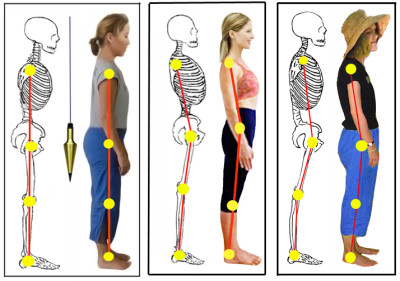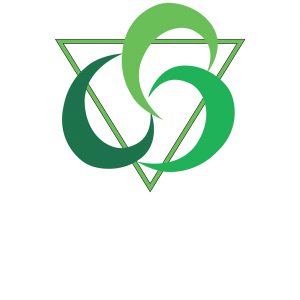“Good posture is important to good health. But what exactly is good posture? Most of us have learned to stand erect by tucking under our tail bones, lifting the chest, pulling back the shoulders, and drawing in the belly. Although that is normal posture today, Kathleen Porter, author of Ageless Spine, Lasting Health says that
Natural posture is the alignment that we instinctively use when we first learn to walk. As toddlers, we practised over and over again until we found the central axis that aligns our bones so we can support our head and walk upright. If you spend some time watching toddlers, you will see true, natural alignment. Notice how toddlers’ little bums jut out behind them, their round bellies relax naturally, and their spines remain long and extended. They walk with proud acceptance of who they are.
As toddlers discover the world around them, pay attention to how they bend and sit: their spines remain long and extended. (Studying toddlers is a fun way to practise your Bowen observational skills.) As we go through life, however, many of us lose this natural alignment. It can begin when babies are put into certain strollers, car seats and carriers that often place the pelvis in a backward tilt. Classroom desk chairs can contribute to the problem. In addition, many hours are spent in sedentary activities at the computer or watching television with little or no attention given to proper alignment.
Many of the models or actors on TV, in movies or in advertisements do not have natural alignment. In perfume and clothing ads, the slouch of models is meant to be sexy, but this slouch collapses the chest and spine. These postures are often adopted, whether consciously or subconsciously, by those wishing to emulate that supposed sexiness. Practise your Bowen observational skills again and study the youth around you. Undoubtedly, you will see the pervasiveness of the slouch posture.
In contrast to the slouch, we have the ‘fitness posture.’ In this case, the posture is based on society’s definition of good posture and fitness, usually with tight, flat abs and overly developed muscles throughout the body. When the body is not in natural alignment, stronger muscles become necessary to hold the body in its unnatural position.
As Porter explains, one can have strength from developed muscles, but there is also the power that comes from aligned bones.
It is this alignment of the spine along the central axis and the position of the bones in relationship to each other that determines whether one will experience back pain or not. Indeed, muscle development can interfere with a quality of relaxed strength that is essential for living in a comfortable, pain-free body. Standing straight, at least in the way most of us have been taught, actually causes the spine to be arched and compressed.
So, after years of ingrained physical habits, how does one return to natural alignment?
Practise, practise, practise! And I might add, complement this with Bowen! To re-discover your central axis or home base as Porter calls it, simply:
- Stand with your heels about 6 inches (15cm) apart and toes 8 inches (20cm) apart
- Bow at the hips slightly until you can see your ankles
- Relax the belly
- While maintaining the position of the hips, lift your face enough to see out in front of you
- Relax
When you find your home base (try it now!) you will immediately see the similarity between home base and the starting position for Sacral Procedure. Is it coincidence that the pelvis is put into natural alignment before we do the moves of the Sacral Procedure? The first words clients usually say after receiving this procedure are, ‘I feel taller,’ then we see that they are walking straighter with head and spine more erect.
Both Bowenwork and finding this home base provide symmetry of alignment that ‘is important for unimpeded transmission of messages and electrical impulses through neural pathways throughout the body.’
Porter states that no muscles are more important to this natural posture than the diaphragm, rectus abdominis, transversus abdominis and the psoas muscles. It is the alignment of our bones, she says, that determines whether these muscles are free to relax or not. In other words, muscles relax when bones are aligned. Through Bowen, we also know the reverse – when muscles relax, bones align! Think of the moves that affect these particular muscles: moves 3 to 5 of Respiratory and Gallbladder Procedures; move 2 of Coccyx Procedure; and move 4 of Pelvic Procedure.
True abdominal core strength, says Porter, is a result of living in an aligned way. Transversus abdominis is designed to stabilize our structure, but it is unable to provide this support when rectus abdominis is contracted too tightly.
‘Tightening of the rectus abdominis muscle draws the pubis symphysis upward, causing the pelvis to tuck under. This results in shortened hamstring muscles which contribute to a backward tilt of the pelvis, interfering with the necessary angle of the sacral platform to support the spine. This is often counteracted by collapsing the spine, lifting the chest, tensing the torso and neck and stressing the nervous system.”
This artificial strengthening of abdominal muscles occurs when we try to achieve tight, flat abs – one of the modem symbols of fitness. Achieving those six-pack abs is the modem equivalent of wearing a tight corset or girdle that restricts the diaphragm. This ultimately affects our overall health, as well as how we age. Understanding natural alignment and the implications for health has changed my beliefs about what a fit body should look like. Now when I see muscular figures, such as body builders with broad shoulders and narrow pelvis, I wonder how that is affecting digestion and respiration, and I wonder if they will have back pain in later years.
Like rectus abdominus, the psoas also becomes tight and shortened from exercises that are meant to flatten the belly. A relaxed psoas is vital to free movement of pelvis and diaphragm, for soft natural breathing, an extended spine and an engaged parasympathetic nervous system (relaxation response). Moves of Pelvic and Coccyx procedures, as well as Special Procedures, relax the psoas.
Another important muscle is gluteus maximus which works as the primary hip extensor, moving us forward when we walk in natural alignment. Buttocks that have a flattened look indicate retroversion of the pelvis. Tom Bowen must have agreed with the importance of this muscle since the moves over the glutes are repeated in BRMI. A better understanding of the relationship between gluteus maximus and natural alignment has helped motivate me to master the technique of BRMI moves 3 & 4 and 9 & 10.
‘The more we understand how our bodies are designed to work, the more tools we have to work with in implementing changes in the way we exercise and move in general.’ And the more we understand how our bodies are designed to work, the better we understand Bowen and the better we become at selecting the correct Bowen moves.

Table 1:
Characteristics that naturally aligned people share when standing:
- Leg bones form vertical columns of support
- Central axis evenly divides the entire body almost in half
- Weight-bearing joints – ankle, knee, hip, shoulder – line up along the central axis
- Pelvis and rib cage are in a natural, neutral position
- Spine is optimally elongated
- Muscles throughout the body are evenly balanced and elastic naturally and are not compressed
- There is an indication toward freedom from pain and tension
Understanding natural posture has increased my patient awareness. During move 4 of Pelvic Procedure, I asked a client to take a deep breath. While I was surprised at the shallowness of her breath, in reviewing this session later in my mind, I remembered that a ‘relaxed psoas is vital to free movement of pelvis and diaphragm, for soft natural breathing.’ And I had been working precisely at move 4 which affects the psoas muscle! (Note: It can also be helpful to change the language with the client to ‘breathe deeply into your belly and let the breath out slowly.’ While anatomically incorrect, this language often helps a client do deep abdominal breathing, instead of shallow chest breathing.)
On completing the Pelvic Procedure, the client’s legs are parallel to each other and in line with the shoulder joint, forming what Porter calls ‘vertical columns of support.’ As I was marvelling at the client’s legs two parallel columns of alignment the client crossed her legs at the ankle! Aghast, I simply placed the client’s feet back in a parallel position and asked her to let them rest there for the duration of the pause.
Natural posture helps the practitioner as well so we can protect our spines for many years of Bowen practise. When working with a client and while waiting to align your move with the breath, take stock of your own posture. It only takes a second to make adjustments so that your hips are at ‘home base’ and your belly is soft and relaxed. When you are aligned and relaxed, this energy is communicated into your moves.
In Ageless Spine, Lasting Health, Porter details how to move in natural alignment while sitting, standing, walking, bending, sleeping, rising from a chair or meditating. It is relatively easy to find home base. We must reconnect with our bodies until natural alignment becomes unconscious habit. In the process, we also require a willingness to release deep-seated beliefs, such as what is health versus what is fitness, and sometimes changing the mind is the most difficult task of all. But when we release our minds, the tensions of our bodies also release, our bones realign, and we are rewarded with strength, flexibility, balance, health, and true fitness.”
Donna Costa
London, Ontario, Canada
Originally printed in Bowen Hands, December 2011
Please note: Ageless Spine, Lasting Health is now out of print, replaced by a new publication, Natural Posture for Pain-Free Living. Read more here.


A very interesting article. Tried out the postural stance, haha, felt like I was slouching, but true, the stance is the beginning of Sacral procedure